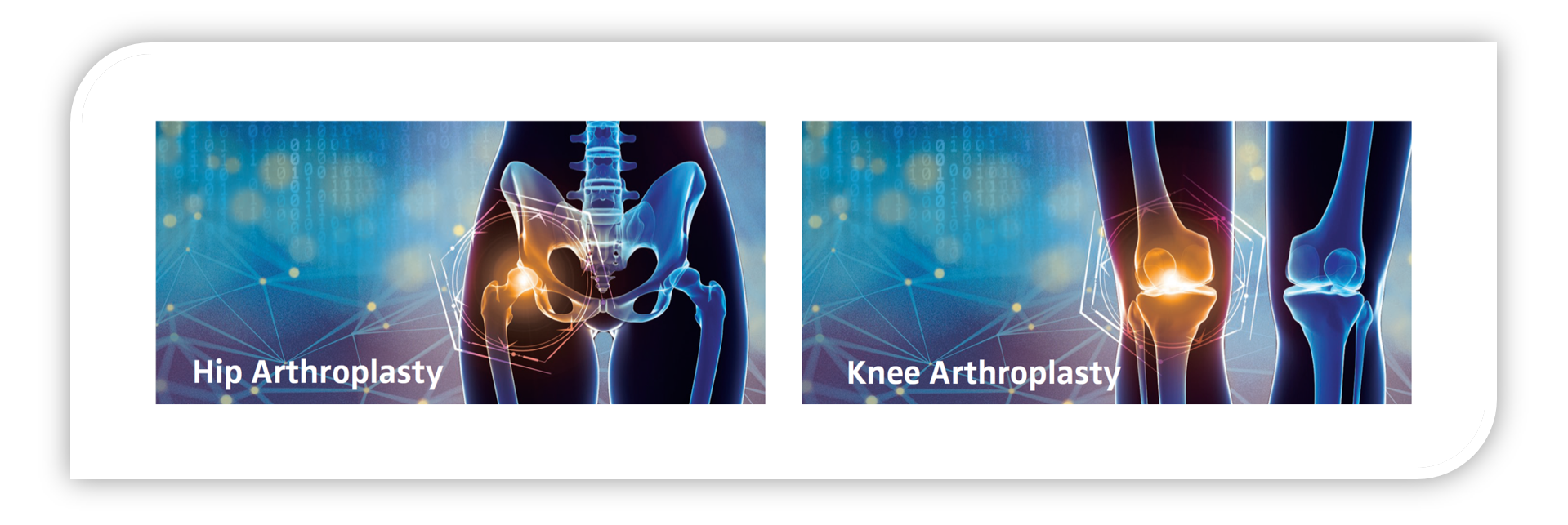
This article first appeared in the December issue of AAOS Now, the monthly news magazine of the American Academy of Orthopaedic Surgeons (AAOS).
The Annual Report of the Academy’s American Joint Replacement Registry (AJRR), released at the Annual Meeting of the American Association of Knee and Hip Surgeons (AAHKS) in November 2020, tells the story of a year marked by a multitude of successes and growth for AJRR.
AJRR made news in June when it crossed the mark of two million hip and knee procedures as reported by more than 1,300 enrolled sites, with an overall cumulative procedural volume growth of 24.4 percent compared to the previous year.
“The COVID-19 pandemic has led to unprecedented times in the United States and the world. Yet AJRR and the development of the AAOS Family of Registries continue to see unprecedented growth and expansion,” said Bryan D. Springer, MD, FAAOS, chair of the AJRR Steering Committee. “This success is a tribute to the nation’s understanding of the fundamental importance of national registries but also to the value that our registry brings to surgeons, hospitals, and other stakeholders every day. Our procedural growth of over two million and counting is rivaled by continued growth of data reuse opportunities for participation in multiple public and private value-based care incentive programs.”
James A. Browne, MD, FAAOS, chair of the AJRR Publications Subcommittee, commented, “As the definitive chronicle of joint replacement in the United States, this year’s AJRR Annual Report continues to build on previous work and demonstrates the incredible value of AJRR.” He noted that more sophisticated and detailed survivorship curves have been included in this year’s overview, including device-specific cumulative revision curves. “The breadth of data reporting has also been expanded and now includes analyses of topics such as type of anesthesia, discharge disposition, and BMI. This report shows how far AJRR has come in just a few short years,” he said.
The following are AJRR achievements over the period through December 31, 2019, which are detailed in the report.
Ambulatory Surgery Centers (ASCs)
Because ASCs historically were underrepresented in AJRR versus case data from hospitals, AAOS sought to better serve such sites by actively recruiting, educating, and engaging ASCs. That strategic refocus has been successful, as the number of ASCs participating in the registry grew by 38.7 percent between July 1, 2018, and December 31, 2019. To continue the trend, AAOS partnered with the Ambulatory Surgery Center Association and began a pilot program that provides the data submission framework necessary for ASCs with low-volume and/or limited technical capabilities. The partnership enables ASCs to demonstrate their value as viable sources of health care.
Patient-reported Outcome Measures (PROMs)
PROMs are increasingly being utilized to evaluate success of hip and knee arthroplasty procedures, with many stakeholders seeking to capture patient perspectives to best provide a full picture for surgical outcome evaluation. AJRR has made a commitment to facilitating capture of those useful data, specifically with the RegistryInsights® PROM platform for facilities to easily collect and upload PROM submissions to the registry. Additionally, AJRR has formed multiple partnerships, expanding the Authorized Vendor Program, to include even more PROM technological vendors. By the end of 2019, 209 sites had submitted PROMs, an increase of more than 13 percent over the previous year.
Tracking and Monitoring Outcomes
Collection of longitudinal patient information continues to be a focus of the AAOS Registry Program. To help sites best utilize registry data for that purpose, RegistryInsights® has been expanded and enhanced. Participating institutions now may access their own real-time dashboards comparing their metrics to the AJRR national benchmark. Separately, the sites’ surgeons may view their own dashboards based on data submitted on procedures they performed. AJRR also offers either site-of-service or surgeon-specific custom reports, which enable surgeons and participating institutions to reuse their registry data for internal performance measures or benchmarks.
Publications and Presentations
A number of studies and educational sessions based on AJRR data were offered over the year and on an ongoing basis. They have included presentations at the 2019 National Association of Orthopaedic Nurses Annual Meeting, as well as podium presentations and posters at the 2019 AAOS, 2020 AAHKS, 2020 International Society of Arthroplasty Registries, 2020 The Knee Society, and 2020 The Hip Society Annual Meetings. AJRR-generated studies have appeared in a number of peer-reviewed journals. A list of publications is available in Appendix G of the Annual Report.
The Power of Reuse
This year’s report also details the numerous ways that registry data may be reused and deployed to enable performance measurement as well as facilitate national registry-driven quality-improvement programs. Among them are the following:
- The Joint Commission Advanced Certification for Total Hip and Total Knee Replacement
- American Board of Orthopaedic Surgery Maintenance of Certification program for Part II Self-Assessment Examination credit
- Centers for Medicare & Medicaid Services (CMS) Bundled Payments for Care Improvement Advanced for the 2021 reporting year
- CMS Comprehensive Care for Joint Replacement Model
- CMS Merit-based Incentive Payment System Promoting Interoperability and Quality Payment Program
- Accreditation Association for Ambulatory Health Care Advanced Orthopaedic Certification
- Aetna Institutes of Quality Orthopaedic Surgery
- BlueCross BlueShield Blue Distinction Specialty Care
- BlueShield of California waiver of prior authorization for their patients’ hip or knee replacement procedures
- Bree Collaborative
- Cigna Surgical Treatment Support Program
- DNV GL Orthopaedic Center of Excellence
- The Alliance Quality Path
Highlights and Trends
The Annual Report represents 1,897,050 primary and revision hip and knee arthroplasty procedures performed between 2012 and 2019. Primary knee (53 percent) and primary hip (33 percent) procedures comprised the majority. Sex breakdown was 59 percent female for all cases. The average age of a total hip arthroplasty (THA) patient was 66.0 years and 66.9 years for total knee arthroplasty (TKA) cases. Most of the patients in the data were white (74 percent), although race was unreported in 16 percent of cases. Among AJRR surgeons performing elective primary THA and TKA procedures separately, the mean procedure counts were 29.2 and 38.5, respectively.
Many trends identified in previous AJRR Annual Reports remain consistent. For hip arthroplasty procedures, there is still a trend toward increased use of ceramic heads. The use of antioxidant polyethylene liners has remained stable. Usage of dual mobility constructs has continued to increase in both the primary and revision settings. Although hemiarthroplasties still predominate for the treatment of femoral neck fractures (FNFs), THA usage has increased. The use of cement for femoral component fixation is slowly increasing for both elective primary TKA as well as arthroplasty for FNF.
For TKA procedures, the usage of cruciate-retaining and ultracongruent implants continues to increase at the expense of posterior stabilized designs. Although cemented fixation still predominates, the use of cementless fixation continues to increase and is now used in 10 percent of all primary TKA procedures. Usage of conventional polyethylene continues to slowly decrease as the usage of highly crosslinked polyethylene inserts continues to increase. Partial knee arthroplasties continue to represent a small percentage of knee arthroplasty cases in the registry, although the percentage has slightly increased over the past two years.
For both hip and knee arthroplasty procedures, postoperative length of stay continues to decrease. The use of spinal anesthesia appears to be slowly increasing, and an association was seen between obesity and increased rates of revision.
Finally, enhanced analytics is always the goal of each Annual Report. With the continued growth of AJRR, analyses with registry data will continue to mature. For the first time this year, cumulative incidence of revision curves was used to examine survivorship. The year 2019 represents the third year completing curves of revision over time and utilizing CMS data. Component-specific statistical summaries have been added to the report this year, displaying common components utilized in hip and knee arthroplasties as well as device-specific cumulative percent revision curves as presented in the AJRR 2019 Annual Report Supplement. Much time was spent establishing a consensus-driven methodology determined by multiple stakeholders. The framework provides a foundation ensuring strength in all analyses moving forward, progressing toward more sophisticated and detailed survivorship curves in the future.
Antonia Chen, MD, MBA, FAAOS, a surgeon and researcher at Brigham and Women’s Hospital, commented, “AJRR is a powerful resource that we can utilize as arthroplasty surgeons, especially to conduct relevant clinical study projects.” She noted that through the AJRR Research Subcommittee, “Individuals can submit proposals to explore topics that are better answered using a large database. Typically, most orthopaedic research is conducted out of single or multiple institutions. Using the AJRR database to perform these large-scale studies demonstrates the Academy’s dedication to conducting findings that can potentially detect implant problems early on and elucidate answers to questions that are better answered with larger databases.”
Be sure to leave a comment in the form below!



